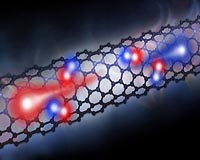 |
Argonne, IL (SPX) Oct 21, 2010 For the first time scientists have been able to watch nanoparticles grow from the earliest stages of their formation. Nanoparticles are the foundation of nanotechnology and their performance depends on their structure, composition, and size. Researchers will now be able to develop ways to control conditions under which they are grown. The breakthrough will affect a wide range of applications including solar-cell technology and chemical and biological sensors. The research is published in NANOLetters. As coauthor Wenge Yang of the Carnegie Institution's Geophysical Laboratory explained: "It's been very difficult to watch these tiny particles be born and grow in the past because traditional techniques require that the sample be in a vacuum and many nanoparticles are grown in a metal-conducting liquid. "So we have not been able to see how different conditions affect the particles, much less understand how we can tweak the conditions to get a desired effect." These researchers work at the Center for Nanoscale Materials and the Advanced Photon Source (APS)-both operated by Argonne National Laboratory-and the High Pressure Synergetic Consortium (HPSynC), a program jointly run by the Geophysical Laboratory and Argonne. The scientists used high-energy X-rays from the APS to carry out diffraction studies that enabled them to gain information on the crystal structure of the materials. Thanks to the highly brilliant and high penetration of this X-ray source-the largest of its kind in the US-the researchers were able to watch the crystals grow from the beginning of their lives. The atoms scatter very short wavelength X-rays and the resulting diffraction pattern reveals the structure of these unusual particles. Quite often the chemical reaction occurs in a very short time and then evolves. The scientists used highly focused high-energy X-rays and a fast area detector, the key components to make this investigation possible. This is the first time-resolved study of the evolution of nanoparticles from the time they are born. HPSynC, is also a part of the Energy Frontier for Research in Extreme Environments (EFree) Center, an Energy Frontier Research Center supported at Carnegie by DOE-BES. One of the missions of this center is to harness new synchrotron radiation techniques for in situ studies of materials structure and dynamics in extreme conditions and thereby to understand and produce new energy materials. "This study shows the promise of new techniques for probing crystal growth in real time. Our ultimate goal is to use these new methods to track chemical reactions as they occur under a variety of conditions, including variable pressures and temperatures, and to use that knowledge to design and make new materials for energy applications. This is a major thrust area of the HPSynC program that we have launched in partnership with Argonne National Laboratory," remarked Russell Hemley, the director of Geophysical Laboratory.
Share This Article With Planet Earth
Related Links Carnegie Institution Nano Technology News From SpaceMart.com Computer Chip Architecture, Technology and Manufacture
 The Effects Of Hydrogen On Growing Carbon Nanotubes
The Effects Of Hydrogen On Growing Carbon NanotubesWashington DC (SPX) Oct 13, 2010 Carbon nanotubes - long, hollow cylinders of carbon billionths of a meter in diameter - have many potential uses in nanotechnology, optics, electronics, and many other fields. The exact properties of nanotubes depend on their structure, and scientists as yet have little control over that structure, which is determined during the initial formation - or growth - of the nanotubes. In fact, sa ... read more |
|
| The content herein, unless otherwise known to be public domain, are Copyright 1995-2010 - SpaceDaily. AFP and UPI Wire Stories are copyright Agence France-Presse and United Press International. ESA Portal Reports are copyright European Space Agency. All NASA sourced material is public domain. Additional copyrights may apply in whole or part to other bona fide parties. Advertising does not imply endorsement,agreement or approval of any opinions, statements or information provided by SpaceDaily on any Web page published or hosted by SpaceDaily. Privacy Statement |